CHAPTER 12
CALIFORNIA RESIDENTIAL CODE
(Added by O-3909)
812.1.1 ADOPTION OF CALIFORNIA RESIDENTIAL CODE.
Those certain documents in book form entitled "California Residential Code with Appendices," 2022 Edition, published by the California Building Standards Commission, not less than one (1) copy each of which have been and are now filed in the office of the City Clerk of the City of Torrance, save and except such portions as are hereinafter deleted, modified, or amended by the ordinance codified in this article, are hereby adopted by the City Council of the City of Torrance as the Residential Code and Standards of the City of Torrance.
812.2.1 AUTHORITY. [ADMINISTRATIVE]
A new section R104.12 is added to the California Residential Code, 2022 Edition, to read in its entirety as follows:
R104.12 Authority. The Building Official shall have the authority to adopt rules and regulations to clarify and interpret the provisions of this ordinance. The Building Official may also approve variations and omissions when such variation or omissions are not detrimental to the life, health, safety, or welfare of the public, and do not violate the intent or purpose of this code.
812.2.2 ENFORCEMENT. [ADMINISTRATIVE]
A new section R113.5 is added to the California Building Code, 2022 Edition, to read in its entirety as follows:
R113.5 Enforcement. The Building Official may require that a registered design professional evaluate the unpermitted work and prepared mitigation plans to mitigate such works.
812.2.3 WOODFRAME STRUCTURES. [GEOLOGICAL]
Section R301.1.3.2 of the 2022 Edition of the California Residential Code is amended to read as follows:
R301.1.3.2 Woodframe structures. The building official shall require construction documents to be approved and stamped by a California licensed architect or engineer for all dwellings of woodframe construction more than two stories and basement in height located in Seismic Design Category A, B or C. Notwithstanding other sections of law; the law establishing these provisions is found in Business and Professions Code Sections 5537 and 6737.1.
The building official shall require construction documents to be approved and stamped by a California licensed architect or engineer for all dwellings of woodframe construction in Seismic Design Category D0, D1, or D2.
812.2.4 SEISMIC PROVISIONS ON SLOPES. [GEOLOGICAL]
Section R301.1.5 is added to Chapter 3 of the 2022 Edition of the California Residential Code to read as follows:
R301.1.5 Seismic design provisions for buildings constructed on or into slopes steeper than one unit vertical in three units horizontal (33.3 percent slope). The design and construction of new buildings and additions to existing buildings when constructed on or into slopes steeper than one unit vertical in three units horizontal (33.3 percent slope) shall comply with Section 1613.6 of the California Building Code.
812.2.5 ANCHORAGE OF MECHANICAL, ELECTRICAL, OR PLUMBING COMPONENTS AND EQUIPMENT. [GEOLOGICAL]
Section R301.2.2.11 is added to Chapter 3 of the 2022 Edition of the California Residential Code to read as follows:
R301.2.2.11 Anchorage of mechanical, electrical, or plumbing components and equipment. Mechanical, electrical, or plumbing components and equipment shall be anchored to the structure. Anchorage of the components and equipment shall be designed to resist loads in accordance with the California Building Code and ASCE 7, except where the component is positively attached to the structure and flexible connections are provided between the component and associated ductwork, piping, and conduit; and either
1. The component weighs 400 lb (1,780 N) or less and has a center of mass located 4 ft (1.22 m) or less above the supporting structure; or
2. The component weighs 20 lb (89N) or less or, in the case of a distributed system, 5 lb/ft (73 N/m) or less.
812.2.6 REPLACEMENT WINDOWS FOR EMERGENCY ESCAPE AND RESCUE OPENINGS
Section R310.5 of the 2022 Edition of the California Residential Code is amended to read as follows:
R310.5 Replacement Windows for Emergency Escape and Rescue Openings. Replacement windows shall comply with Sections R310.2 and R310.4.4.
812.2.7 WINDOW OPENING HEIGHT [GEOLOGICAL]
Section R312.2.1 of the 2022 Edition of the California Residential Code is amended to read as follows:
R312.2.1 Window opening height. In dwelling units, where the bottom of the clear opening of an operable window opening is located less than 36 inches above the finished floor and greater than 72 inches above the finished grade or other surface below on the exterior of the building, the operable window shall comply with one of the following:
1. Operable window openings will not allow a 4-inch diameter sphere to pass through where the openings are in their largest opened position.
2. Operable windows are provided with window opening control devices or fall prevention devices that comply with ASTM F2090.
812.2.8 NEW OPENINGS
A new section R337.8.5 is added to the California Residential Code, 2022 Edition, to read in its entirety as follows:
R337.8.5 New Openings. New window and door openings shall comply with R703.4. Retrofit window and door are not allowed in new framed or existing non-conforming openings.
812.2.9 WOOD FOUNDATIONS. [GEOLOGICAL]
Section R401.1 of the 2022 Edition of the California Residential Code is amended to read as follows:
R401.1 Application. The provisions of this chapter shall control the design and construction of the foundation and foundation spaces for buildings. In addition to the provisions of this chapter, the design and construction of foundations in flood hazard areas as established by Table R301.2 shall meet the provisions of Section R322. Wood foundations shall be designed and installed in accordance with AWC PWF.
Exception: The provisions of this chapter shall be permitted to be used for wood foundations only in the following situations:
1. In buildings that have no more than two floors and a roof.
2. When interior basement and foundation walls are constructed at intervals not exceeding 50 feet (15 240 mm).
Wood foundations in Seismic Design Category D0, D1, or D2 shall not be permitted.
Exception: In non-occupied, single-story, detached storage sheds and similar uses other than carport or garage, provided the gross floor area does not exceed 200 square feet, the plate height does not exceed 12 feet in height above the grade plane at any point, and the maximum roof projection does not exceed 24 inches.
812.2.10 FOOTINGS. [GEOLOGICAL]
Sections R403.1.2, R403.1.3.6 and R403.1.5 of the 2022 Edition of the California Residential Code are amended to read as follows:
R403.1.2 Continuous footing in Seismic Design Categories D0, D1 and D2. Exterior walls of buildings located in Seismic Design Categories D0, D1 and D2 shall be supported by continuous solid or fully grouted masonry or concrete footings. Required interior braced wall panels in buildings located in Seismic Design Categories D0, D1 and D2 shall be supported on continuous foundations.
R403.1.3.6 Isolated concrete footings. In detached one- and two-family dwellings located in Seismic Design Category A, B, or C, that are three stories or less in height, and constructed with stud bearing walls, isolated plain concrete footings supporting columns or pedestals are permitted.
R403.1.5 Slope. The top surface of footings shall be level. The bottom surface of footings shall not have a slope exceeding one unit vertical in 10 units horizontal (10-percent slope). Footings shall be stepped where it is necessary to change the elevation of the top surface of the footings or where the slope of the bottom surface of the footings will exceed one unit vertical in 10 units horizontal (10-percent slope).
For structures assigned to Seismic Design Categories D0, D1 or D2, stepped footings shall be reinforced with four No. 4 rebar. Two bars shall be placed at the top and bottom of the footings as shown in Figure R403.1.5.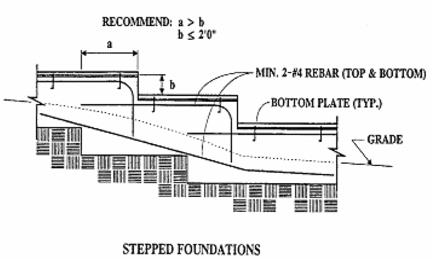
FIGURE R403.1.5
STEPPED FOOTING
812.2.11 WOOD FOUNDATION WALLS. [GEOLOGICAL]
Section R404.2 of the 2022 Edition of the California Residential Code is amended to read as follows:
R404.2 Wood foundation walls. Wood foundation walls shall be constructed in accordance with the provisions of Sections R404.2.1 through R404.2.6 and with the details shown in Figures R403.1(2) and R403.1(3). Wood foundation walls shall not be used for structures located in Seismic Design Category D0, D1 or D2.
812.2.12 APPLICATION. [ADMINISTRATIVE]
Section R501.2 of the 2022 Edition of the California Residential Code is amended to read as follows:
R501.2 Requirements. Floor construction shall be capable of accommodating all loads in accordance with Section R301 and of transmitting the resulting loads to the supporting structural elements. Mechanical or plumbing fixtures and equipment shall be attached or anchored to the structure in accordance with Section R301.2.2.11.
812.2.13 FASTENING SCHEDULE. [GEOLOGICAL]
Lines 20, 21, 24, and 34 – 37 of Table R602.3(1) of the 2022 Edition of the California Residential Code are amended to read as follows:
|
ITEM |
DESCRIPTION OF BUILDING ELEMENTS |
NUMBER AND TYPE OF FASTENERa, b, c |
SPACING AND LOCATION |
|
|---|---|---|---|---|
|
20k |
1" × 6" sheathing to each bearing |
3-8d box (2 1/2" × 0.113"); or |
Face nail |
|
|
21k |
1" × 8" and wider sheathing to each bearing |
3-8d box (2 1/2" × 0.113"); or |
Face nail |
|
|
|
|
Wider than 1" × 8" |
||
|
Floor |
||||
|
24k |
1" × 6" subfloor or less to each joist |
3-8d box (2 1/2" × 0.113"); or |
Face nail |
|
|
Other wall sheathingg |
||||
|
34k |
1/2" structural cellulosic fiberboard sheathing |
1 1/2" × 0.120" galvanized roofing nail, 7/16" head diameter, or 1 1/4" long 16 ga. staple with 7/16" or 1" crown |
3 |
6 |
|
35k |
25/32" structural cellulosic fiberboard sheathing |
1 3/4" × 0.120" galvanized roofing nail, 7/16" head diameter, or 1 1/4" long 16 ga. Staple with 7/16" or 1" crown |
3 |
6 |
|
36k |
1/2" gypsum sheathingd |
1 1/2" × 0.120" galvanized roofing nail, 7/16" head diameter, or 1 1/4" long, 16 ga.; staple galvanized, 1 1/2" long; 7/16" or 1" crown or 1 1/4" screws, Type W or S |
7 |
7 |
|
37k |
5/8" sheathingd |
1 3/4" galvanized roofing nail, 7/16" head diameter, or 1 1/4" long, 16 ga.; staple galvanized, 1 1/2" long; 7/16" or 1" crown or 1 1/4" screws, Type W or S |
7 |
7 |
k) Use of staples in roof, floor, and braced wall panels shall be prohibited in Seismic Design Category D0, D1, or D2.
812.2.14 TOP PLATE. [GEOLOGICAL]
Exception of Section R602.3.2 and Table R602.3.2 of the 2022 Edition of the California Residential Code is amended to read as follows:
Exception: In other than Seismic Design Category D0, D1 or D2, a single top plate used as an alternative to a double top plate shall comply with the following:
1. The single top plate shall be tied at corners, intersecting walls, and at in-line splices in straight wall lines in accordance with Table R602.3.2.
2. The rafters or joists shall be centered over the studs with a tolerance of not more than 1 inch (25 mm).
3. Omission of the top plate is permitted over headers where the headers are adequately tied to adjacent wall sections in accordance with Table R602.3.2.
812.2.15 TABLE R602.3(2) ALTERNATE ATTACHMENTS. [GEOLOGICAL]
Footnote "b" of Table R602.3(2) of the 2022 Edition of the California Residential Code is amended to read as follows:
b. Staples shall have a minimum crown width of 7/16-inch on diameter except as noted. Use of staples in roof, floor, subfloor, and braced wall panels shall be prohibited in Seismic Design Category D0, D1, or D2.
812.2.16 BRACING REQUIREMENTS BASED ON SEISMIC DESIGN CATEGORY. [GEOLOGICAL]
Table R602.10.3(3) of the 2022 Edition of the California Residential Code is amended to read as follows: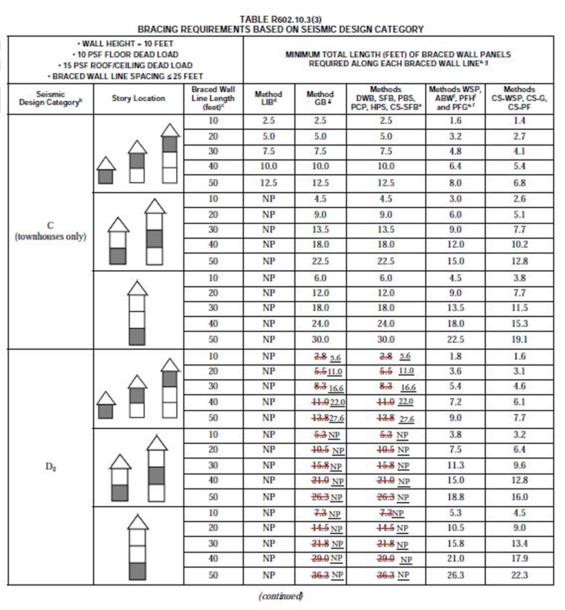
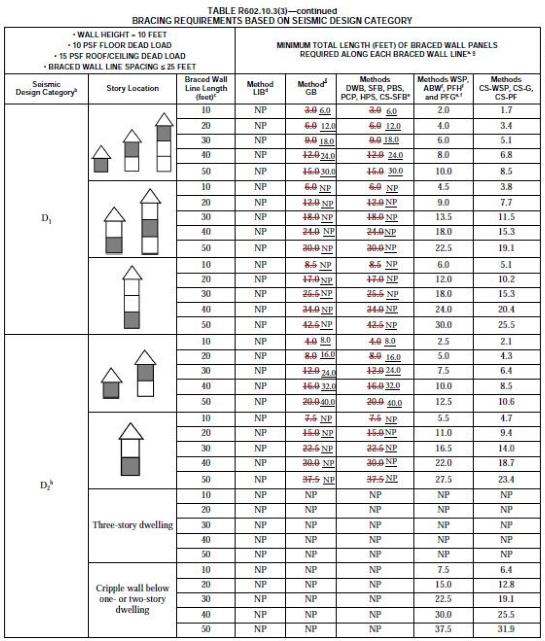
a. Linear interpolation shall be permitted.
b. Interpolation of bracing length between the Sds values associated with the seismic design categories shall be permitted when a site-specific Sds value is determined in accordance with Section 1613.2 of the California Building Code.
c. Where the braced wall line length is greater than 50 feet, braced wall lines shall be permitted to be divided into shorter segments having lengths of 50 feet or less, and the amount of bracing within each segment shall be in accordance with this table.
d. Method LIB shall have gypsum board fastened to not less than one side with nails or screws in accordance with Table R602.3(1) for exterior sheathing or Table R702.3.5 for interior gypsum board. Spacing of fasteners at panel edges shall not exceed 8 inches.
e. Methods PFG and CS-SFB do not apply in Seismic Design Categories D0, D1 and D2.
f. Methods PFH, PFG and ABW are only permitted on a single story or a first of two stories.
g. Where more than one bracing method is used, mixing methods shall be in accordance with Section R602.10.4.1.
h. One- and two-family dwellings in Seismic Design Category D2 exceeding two stories shall be designed in accordance with accepted engineering practice.
i. Methods GB and PCP braced wall panel h/w ratio shall not exceed 1:1 in SDC D0, D1 and D2. Methods DWB, SFB, PBS, HPS, and CS-SFB are not permitted in D0, D1 and D2.
812.2.17 BRACING METHODS. [GEOLOGICAL]
Table R602.10.4 of the 2022 Edition of the California Residential Code is amended to read as follows:
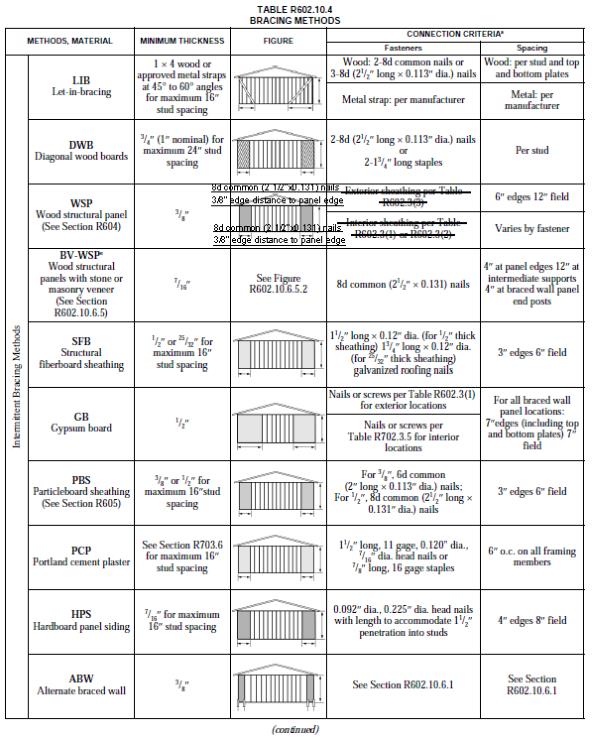
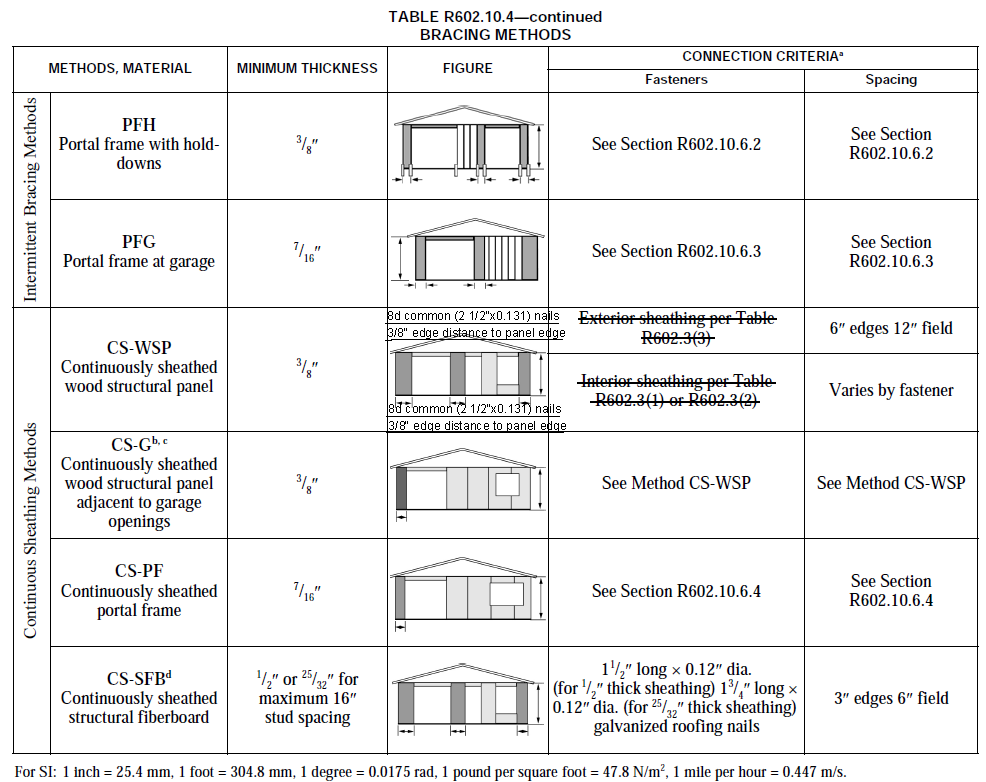
a. Adhesive attachment of wall sheathing, including Method GB, shall not be permitted in Seismic Design Categories C, D0, D1 and D2.
b. Applies to panels next to garage door opening where supporting gable end wall or roof load only. Shall only be used on one wall of the garage. In Seismic Design Categories D0, D1 and D2, roof covering dead load shall not exceed 3 psf.
c. Garage openings adjacent to a Method CS-G panel shall be provided with a header in accordance with Table R602.7(1). A full-height clear opening shall not be permitted adjacent to a Method CS-G panel.
d. Method CS-SFB does not apply in Seismic Design Categories D0, D1 and D2.
e. Method applies to detached one- and two-family dwellings in Seismic Design Categories D0 through D2 only.
f. Methods GB and PCP braced wall panel h/w ratio shall not exceed 1:1 in SDC D0, D1 and D2. Methods LIB, DWB, SFB, PBS, HPS, and PFG are not permitted in SDC D0, D1 and D2.
g. Use of staples in braced wall panels shall be prohibited in SDC D0, D1 and D2.
812.2.18 MINIMUM LENGTH OF BRACED WALL PANELS. [GEOLOGICAL]
Table R602.10.5 of the 2022 Edition of the California Residential Code is amended to read as follows:
TABLE R602.10.5
MINIMUM LENGTH OF BRACED WALL PANELS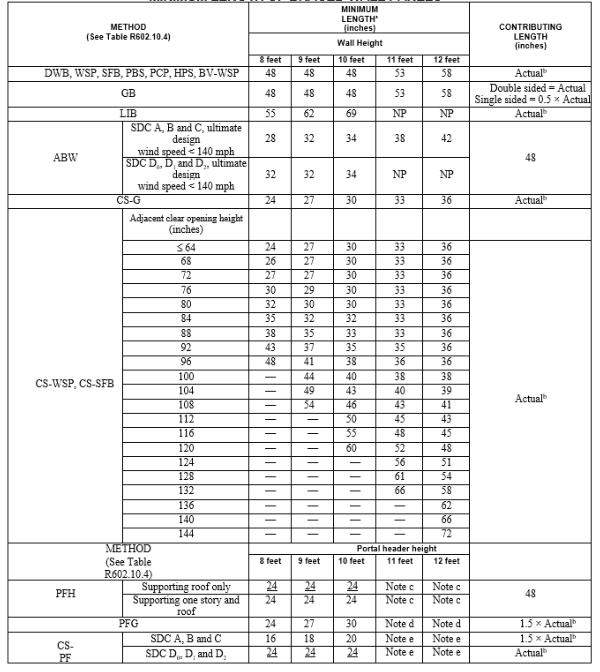
For SI: 1 inch = 25.4 mm, 1 foot = 304.8 mm, 1 mile per hour = 0.447 m/s.
NP = Not Permitted.
a. Linear interpolation shall be permitted.
b. Use the actual length where it is greater than or equal to the minimum length.
c. Maximum header height for PFH is 10 feet in accordance with Figure R602.10.6.2, but wall height shall be permitted to be increased to 12 feet with pony wall.
d. Maximum header height for PFG is 10 feet in accordance with Figure R602.10.6.3, but wall height shall be permitted to be increased to 12 feet with pony wall.
e. Maximum header height for CS-PF is 10 feet in accordance with Figure R602.10.6.4, but wall height shall be permitted to be increased to 12 feet with pony wall.
812.2.19 ALTERNATE BRACED WALL PANEL. [GEOLOGICAL]
Figure R602.10.6.1 of the 2022 Edition of the California Residential Code is amended to read as follows: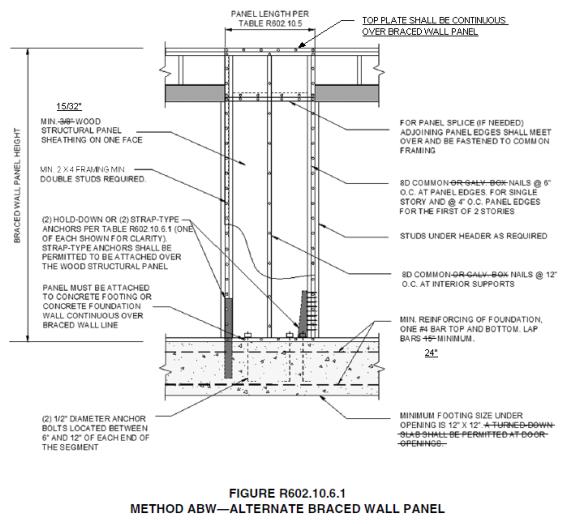
812.2.20 PORTAL FRAME. [GEOLOGICAL]
Figure R602.10.6.2 of the 2022 Edition of the California Residential Code is amended to read as follows: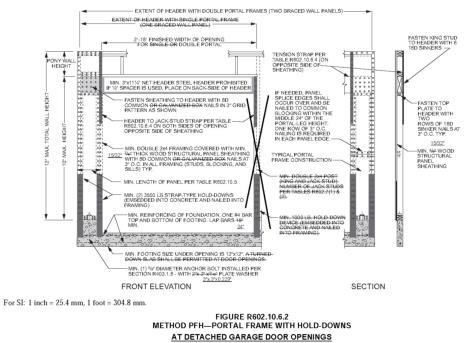
812.2.21 FIGURE R602.
Figure R602.10.6.4 of the 2022 Edition of the California Residential Code is amended to read as follows: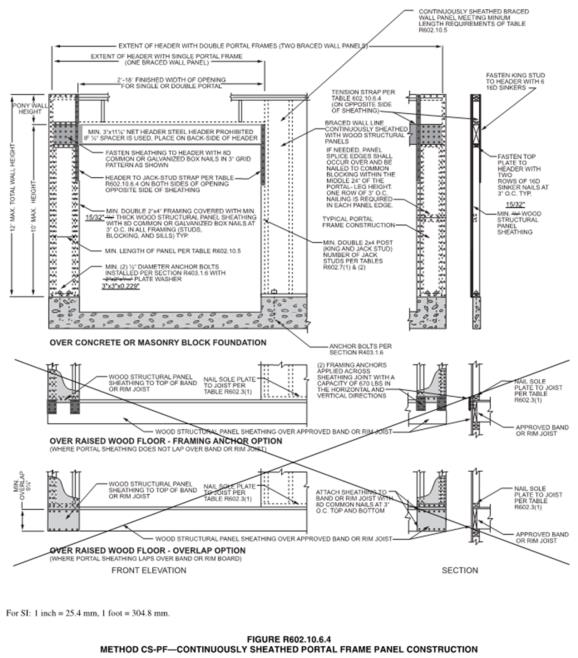
812.2.22 PARAPET WALLS. [GEOLOGICAL]
Section R606.4.4 of the 2022 Edition of the California Residential Code is amended to read as follows:
R606.4.4 Parapet walls. Unreinforced solid masonry parapet walls shall not be less than 8 inches (203 mm) thick and their height shall not exceed four times their thickness. Unreinforced hollow unit masonry parapet walls shall be not less than 8 inches (203 mm) thick, and their height shall not exceed three times their thickness. Masonry parapet walls in areas subject to wind loads of 30 pounds per square foot (1.44 kPa) or located in Seismic Design Category D0, D1 or D2, or on townhouses in Seismic Design Category C shall be reinforced in accordance with Section R606.12.
812.2.23 REINFORCEMENT REQUIREMENTS FOR MASONRY ELEMENTS. [GEOLOGICAL]
Section R606.12.2.2.3 of the 2022 Edition of the California Residential Code is amended to read as follows:
R606.12.2.2.3 Reinforcement requirements for masonry elements. Masonry elements listed in Section R606.12.2.2.2 shall be reinforced in either the horizontal or vertical direction as shown in Figure R606.11(2) and in accordance with the following:
1. Horizontal reinforcement. Horizontal joint reinforcement shall consist of not less than one No. 4 bar spaced not more than 48 inches (1219 mm). Horizontal reinforcement shall be provided within 16 inches (406 mm) of the top and bottom of these masonry elements.
2. Vertical reinforcement. Vertical reinforcement shall consist of not less than one No. 4 bar spaced not more than 48 inches (1219 mm). Vertical reinforcement shall be within 8 inches (203 mm) of the ends of masonry walls.
812.2.24 OPENINGS IN HORIZONTAL DIAPHRAGMS. [GEOLOGICAL]
Section R803.2.4 is added to Chapter 8 of the 2022 Edition of the California Residential Code to read as follows:
R803.2.4 Openings in horizontal diaphragms. Openings in horizontal diaphragms shall conform with Section R503.2.4.
812.2.25 DECK REQUIREMENTS. [GEOLOGICAL]
Section R905.3.1 of the 2022 Edition of the California Building Code is amended to read as follows:
R905.3.1 Deck requirements. Concrete and clay tile shall be installed only over solid sheathing.
Exception: Spaced lumber sheathing in accordance with R803.1 shall be permitted in Seismic Design Categories A, B, and C.
812.2.26 VERTICAL REINFORCEMENT. [GEOLOGICAL]
Section R1001.3.1 of the 2022 Edition of the California Residential Code is amended to read as follows:
R1001.3.1 Vertical reinforcing. For chimneys up to 40 inches (1016 mm) wide, four No. 4 continuous vertical bars adequately anchored into the concrete foundation shall be placed between wythes of solid masonry or within the cells of hollow unit masonry and grouted in accordance with Section R606. Grout shall be prevented from bonding with the flue liner so that the flue liner is free to move with thermal expansion. For chimneys more than 40 inches (1016 mm) wide, two additional No. 4 vertical bars adequately anchored into the concrete foundation shall be provided for each additional flue incorporated into the chimney or for each additional 40 inches (1016 mm) in width or fraction thereof.
812.2.27 PATIO COVER DESIGN LOADS. [GEOLOGICAL]
Section AH105.1 of Appendix H of the California Residential Code, 2022 Edition, is hereby deleted and a new section AH105.1 added to read in its entirety, as follows:
Section AH105.1 Patio Cover Design Loads. Patio covers shall be designed and constructed to sustain, within the stress limits of this code, all dead loads, plus a minimum vertical live load of ten (10) pounds per square foot for detached patios, and twenty (20) pounds per square foot for patios attached to Group R-3 and to Group U occupancies. Such covers shall be designed to resist the minimum horizontal wind loads set forth in this Code. Such covers shall be designed to resist the minimum wind loads set forth in R301.2.1. In addition, they shall be designed to support a minimum wind uplift to horizontal wind load acting vertically upward normal to the roof surface.


